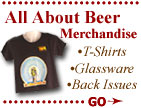
| ||||
| AAB Departments |
| ...Beer Features |
| ...Beer Talk |
| ...Pull Up A Stool! |
| ...What's Brewing |
| ...Beer Travelers |
| ...Stylistically Speaking |
| ...Beer & Food |
| ...Homebrewing |
| ...Collectibles |
| ...Marketplace |
| Beer Lovers' Resources |
| ...World Beer Festival |
| ...Brew Cruise Info |
| ...AAB Merchandise |
| ...AAB Bookstore |
| ...Beer Links |
| About the Magazine |
| ...Subscription Info |
| ...Retail the Magazine |
| ...Advertising Info |
| ...Contact AAB |

|
Bottling alternatives
by Ray DanielsFinding ways to dispense and distribute finished beer is the biggest headache encountered by brewers of all sizes. It is easily half of the battle in producing good beer and it is often times the ruin of good beer instead. Fortunately, many potential solutions have been developed and your fellow brewers have the experience to let you know what works and what doesn't.
In March we asked people to relate their experiences with bottling and its various alternatives. This article is the first of several that will explore the subject in some detail while working in the comments we have received from readers. By the way, there's still time to contribute your own advice or to seek help with a problem you have encountered, just e-mail Ray Daniels Brewing Editor, All About Beer Online.
This month, we'll review some basics about bottling and then move on to discuss some of the simple alternatives that can reduce time and hassle, namely swing top bottles and PET bottles.
Bottling Basics
Some cyberspace brewers have been frustrated by the process of bottling as reflected by the following comments from a recent rec.crafts.brewing post:
The brew kit I bought came with a bottling bucket that has a spigot at the bottom. (Expletive deleted!) It is hard to regulate flow and the backflow comes shooting out the air-hole. I probably ended up spilling 3-12 oz. beers worth!!! *sigh*
Any tips to make bottling easier?? I think my first step is to switch from 12 oz. bottles to 16 oz bottles.
Ron the Brew Novice
Of course Ron's biggest problem is lack of proper equipment. (See our article on Bottling if you want a complete list of bottling equipment and a description of procedures.)
I can't imagine bottling without a bottle filler that includes a spring-actuated plunger at the bottom. This allows precise flow of the beer into the bottles and generally leaves an acceptable head space at the top.
One alternative is "Phil's Philler," an alternative design that allows more control over headspace volume. Unlike normal fillers, the flow control for this device is at the top of the wand rather than the bottom. As a result, the beer that is in the filling wand when you finish a bottle stays in the bottle rather than in the filling wand. As a result, the volume of beer in the bottle does not change noticeably when you remove the wand from the bottle and you can more precisely determine the final volume of the bottle. This is useful when you want to reduce the headspace and thereby reduce the amount of oxygen your beer can absorb during storage.
Another problem that some people report with bottling is calculation of the priming sugar. Andy Ager of Chicago, IL says that he had problems determining the proper priming sugar quantities when splitting a batch between different packaging options. For those of you who occasionally have the same problem, here's a little table to help out. It is based upon the assumption that 3/4 cup of corn sugar is sufficient to carbonate 5 gallons of beer.
Amount of Priming Sugar Required Volume of Beer Cups Tablespoons + Teaspoons 5 gallons 0.75 12 + 0 4 gallons 0.60 9 + 2 3 gallons 0.45 7 + 1 2.5 gallons 0.375 6 + 0 2 gallons 0.300 4 + 2.5 1 gallon 0.150 2 + 1.25 ½ gallon 0.075 1 + 0.5 22 oz 0.025 0 + 1.25 16 oz 0.0188 0 + 0.90 12 oz 0.0140 0 + 0.67
Of course one solution to this is to simply prime the whole five gallons before you begin racking it into the final packages. That way you'll have the proper priming level in all of the beer with no messy calculations.
Alternative BottlesAt one time there was a lot of emphasis on the use of strong, returnable bottles for bottling homebrew. This was motivated by fears of exploding bottles when beer was made the way that grandpa made it. While I have personally exploded one or two bottles (out of a couple thousand filled), it doesn't seem to be a big problem these days. Now, people seem to use a variety of different bottles for their brew, both glass and plastic, with no ill effects reported. Reader Bryan Curran supplies the following experience:
1. I got my start with a Christmas present (Mr. BEER) that comes with 1 ltr plastic bottles and while I don't use the keg any more I do use the bottles.
2. I use 1 ltr RC Cola bottles (yes they are clear but I store them in a cupboard) in a pinch. They are good for giving beer to friends that never return the empties.
3. 2 ltr pop bottles. Funny thing I just opened my first beer bottled in a 2 ltr bottle and sat down to browse beer pages. It tastes fine. I think it would be fine to bring 2 or 3 to a party (with a pitcher) to share.
Overall, my experience with plastic is totally positive. Nontraditional but positive.
Bryan
Bryan notes that the key concern in selecting beer bottles (after strength) is color. Both sunlight and flourescent light can interact with hop compounds in beer to produce a skunky aroma. Brown glass prevents the specific wavelength of light that is responsible for this reaction from reaching the beer; green glass and clear glass do not. While most homebrewers don't need to worry about this problem too much, it can be an issue if you take your beer outdoors in the summer. The skunking reaction takes place after only a few minutes of exposure to sunlight.
A reader named Dan provides some other thoughts on the variety of bottles one can use:
I have also discovered that you can bottle beer in just about any good, dark glass, and sealable container available. I have reused 40 oz. malt liquor bottles just by boiling the screw cap and filling as usual. Pier One, Crate and Barrel, and many other similar places have really cool flip-top style bottles. You can even paint a neat looking bottle if it happens to be clear or green.
Many homebrew stores sell 16-ounce and 22-ounce beer bottles these days and this can be a great way to reduce your bottling chores. By the way, if you're wondering, here's the number of bottles in each size that it takes to package 5 gallons of beer.Five gallons of beer equals:
53 x 12-ounce bottles 40 x 16-ounce bottles 29 x 22-ounce bottlesOf course the bigger the bottle, the more beer you'll have to dispose of each time you open a homebrew. For some people, opening a 22-ounce bottle is no big deal; but for others it rarely seems convenient.
If the 16-ounce size appeals to you, swing-top bottles might be an option. In addition to reducing the number of bottles you need, they speed the bottling process by eliminating the bottle cap. For those who haven't seen these bottles before, a bit more detail is in order.
Swing-top bottles are sometimes called Grolsch bottles after a brand of beer that is commonly sold in this container. They consist of a 16-ounce bottle that has a wire harness and ceramic stopper attached to the top. A small rubber-like ring is attached to the ceramic stopper to ensure a good seal between the stopper and the bottle. Using the wire harness, the stopper can be quickly set and sealed or just as quickly removed for serving. This saves time during bottling and eliminates the need for a bottle opener during serving.
While some readers report good experiences with swing-top bottles, we received at least one report of problems. Thomas J. Hoolan says he's had problems with poor seals on swing-top bottles, saying "Numerous times I've heard carbonation escaping from them." At present, he has given up on swing-tops and uses crimp-cap bottles exclusively.
One factor to keep in mind with swing-tops is the health of the rubber seals. These will deteriorate over time and should be replaced to ensure a good seal. Many good homebrew stores will sell the replacement seals.
Another issue in selecting bottles is aesthetic. Some beer snobs look askance at non-standard bottles -- although most will let it go if the beer is decent. Also, to enter in a registered homebrew competition, you usually need to have your beer in a standard 12-ounce long-neck bottle in brown or perhaps green.
PET Bottles
Finally, we arrive at the issue of PET bottles. These are the plastic one- and two-liter soda bottles that are common in most parts of the U.S. these days. They can be used in a variety of ways to carbonate, store and transport beer.
The bottles themselves are pretty straightforward. One option comes in the caps. Most brewers use the original cap, but you can buy alternative caps that allow you to pressurize the bottle with CO2. Most people use the regular cap and carbonate the beer in the soda bottle the same way they would in a glass bottle. In most cases, this works out just fine. However, reader Thomas Hoolan, warns that each bottle has a limited life:
"[About] 2 years ago, I experimented with plastic 2 liter bottles. They actually seemed to work just fine, however, I would not encourage multiple uses out of the same bottle cap. Usually, when I used a cap, it was no more than two times and during each use, I would tighten it with pliers. A word of warning, after about four uses of the plastic bottle, it would begin to deteriorate and appear to lose strength and firmness. I would not use the same bottle more than four times."
If you already own stainless steel soda kegs, you may use PET bottles -- along with a carbonation cap -- to transport beer to parties or free up an almost-empty keg. The carbonation caps look like the gas inlet valve from a stainless steel soda keg. Once screwed onto the top of a plastic bottle, you can attach the gas fitting from a standard CO2 tank to pressurize the bottle. As a result, you can fill a soda bottle from a keg and then pressurize it to maintain the condition in the beer during storage.
I have also heard of brewers carbonating their beers using these caps. To do so, you would simply fill the bottle with end-fermented and un-primed beer, then pressurize the bottle and shake, rattle and roll to dissolve the CO2 in the beer. When this is repeated an adequate number of times, you could adequately carbonate a beer this way -- but it sure seems like a lot of work.
OK, that does it for bottles, both plastic and glass. If we've missed something drop us a note. Otherwise, you might want to consider German mini-kegs (can anyone make them work?). In the future we'll look at Party Pigs and other alternative bulk containers, as well as soda kegs and their use. Drop us a line with tales of your own experiences in any of these areas.










